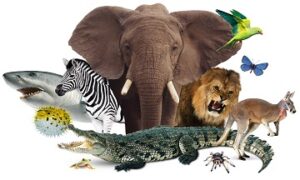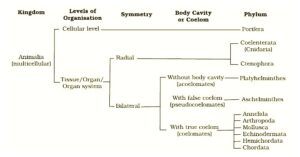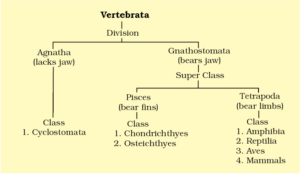Animal Kingdom: Classification, Characteristics, Examples
The Animal Kingdom is a large group that consists of eukaryotic, multicellular organisms that are heterotrophic in nature. As such, they obtain their nutrition from external sources. Although they are unable to produce their own food, which is one of the main defining characteristics of plants, animal cells lack a cell wall that is present in plant cells.
With the exception of a few animals, the majority of animals are motile which allows them to effectively respond to stimuli and find food, etc. In general, animals are divided into two main groups namely, vertebrates (animals with a backbone) and invertebrates (animals that lack a backbone). However, they are also divided into several phyla that will be discussed below in detail.
Basis of Classification
Level of organization–
- Cellular Level – Cells are arranged as loose cell aggregate. E.g., Sponges
- Tissue level- Cells performing the same function are arranged into tissues.
- Organ level – E.g., Platyhelminthes.
- Organ system – Each system is concerned with a specific physiological function.
ü Incomplete digestive system – Single opening to outside the body (serve as mouth and anus). E.g., Platyhelminthes.
ü Complete digestive system– 2 openings- mouth and anus
ü Open circulatory system – Blood is pumped out of the heart and cell & tissues directly both in it.
ü Closed circulatory system – Blood is circulated through series of vessels of different diameters.
Symmetry-
- Asymmetrical – Any plane passing by the centre doesn’t divide into 2 halves. E.g., Sponges.
- Radial- Plane passing by centre divides into 2 halves or more. E.g., Coelenterates, Ctenophores.
- Bilateral – Body can be divided into left & right halves in only 1 plane. E.g., Annelids, arthropods.
Diploblastic and triploblastic-
- Diploblastic – Cells are arranged in 2 embryonic layers- ectoderm & endoderm. An undifferentiated layer- mesoglea in the present between them. E.g., Coelenterates.
- Triploblastic – They have 3rd germinal layer – Mesoderm. E.g., Chordates.
Coelom
Body cavity lined by Mesoderm.
- Coelomates- Possess coelom. E.g.-Annelids, Arthropoda.
- Pseudocoelomates- Mesoderm of the cavity is present as Pouches. E.g., Aschelminthes.
- Acoelomates- Body cavity is absent. E.g.-Platyhelminthes.
Segmentation
The body is externally or internally divided into segments. E.g.-Earthworm- body shows metameric segmentation: metamerism.
Notochord
Mesodermally derived rod-like structure on the dorsal side during Embryonic development.
Classification of Animals–
Phylum – Porifera- (Sponges)
- Cellular level, asymmetrical, acoelomate, intracellular digestion.
- Have a water transport system- water enters through pores (ostia) in body wall into the cavity, spongocoel, then goes to osculum.
- It helps in food gathering, removal of water, respiration.
- Choanocytes or collar cells line spongocoel.
- The body is supported by a skeleton made of spicules or spongin fibre.
- Hermaphrodite – Sexes are not separate.
- E.g., Spongilla, Euspongia (Bath sponge), Sycon (Scypha)
Phylum – Coelenterata (Giardia)-
- Radial, acoelomate, tissue level, Diploblastic.
- Have Cnidoblast (contain stinging capsules or nematocysts).
- Have central gastrovascular cavity with a single opening on hypostome.
- Corals have a skeleton of CaCo3.
- Exhibit 2 basic forms – polyp (sessile, cylindrical like Hydra, Adams) and medusa (Umbrella shaped, E.g., Aurelia, Jellyfish).
- Cnidarian existing in both forms exhibit alternation of generation (metagenesis) – Polyps produce medusae asexually and medusa by sexually.
- E.g., Adamsia (Sea anemone), Pennatula (Sea Pen), Mandarina (Brain coral), Gorgonia (Sea fan), Physalia (Portuguese Man of War)
Phylum – Ctenophora – (Sea walnut/comb jellies)
- Radial, acoelomate, diploblastic, tissue level, sexual reproduction.
- Body bears & rows of ciliated comb plates.
- Bioluminescence (Property to emit light) is well marked.
- E.g.- Pleurobrachia, Ctenoplana
Phylum – Platyhelminthes –
- Bilateral, acoelomate, triploblastic, organ level
- Have dorsoventrally flattened body, so-called flatworms.
- Hooks and suckers are present (absorb nutrients from the host directly).
- Flame cells help in osmoregulation and excretion.
- Planaria possess a high regeneration capacity.
- E.g., Taenia (Tapeworm), Fasciola (Liver Plucks)
Phylum – Aschelminths-
- Circular (roundworm), organ system level, bilateral, triploblastic, pseudocoelomate.
- The digestive system is complete with a developed muscular pharynx.
- Dioecious- separate sexes.
- E.g., Ascaris (roundworm), Wuchereria (filaria worm), Ancylostoma (hookworm)
Phylum – Annelida-
- Organ system level, bilateral, triploblastic, coelomate.
- Segmented body (Metamers) – little rings.
- Longitudinal and circular muscle for locomotion.
- Nereis possess lateral appendages parapodia (swimming), dioecious.
- Nephridia (help in osmoregulation & excretion)
- Paired ganglia are present.
- Earthworm & leeches – monoecious.
- E.g., Nereis, Hirudinea (Bloodsucking leech), Pheretima (Earthworm)
Phylum Arthropoda
- Largest Phylum (2-3rd of all species)
- Organ system, bilateral, triploblastic, coelomate, dioecious.
- It is covered with a cutaneous exoskeleton.
- Has head, thorax and abdomen, jointed appendages
- Respiratory organs – gills, lungs, book lungs, book gills.
- Sensory organ – Antennae, eyes, Statocysts
- Excretion – Through Malpighian tubule.
- E.g., Anopheles, Aedes (Mosquito), culex, Apis (Honey bee), Bombyx (Silkworm), Laccifer (Lac insect), Limulus (Living fossil)
Phylum -Mollusca-
- Second largest organ system, bilateral, triploblastic, coelomate, dioecious.
- Covered with a calcareous shell
- Has head, muscular food and visceral hump.
- Space between hump and mantle – mantle cavity.
- The anterior head has sensory tentacles.
- A file like rinsing organ in the mouth for feeding – radula
- E.g., Pila (Apple snail), Octopus (Devilfish), Dentalium (Tusk shell), Pinctada, Sepia (cuttlefish)
Click Here for Complete Biology Notes
Phylum- Echinodermata-
- Endoskeleton of a calcareous, organ system, radial(adult), Bilateral (larva), triploblastic., coelomate, mouth on the ventral side, anus on the dorsal side.
- Water vascular system – locomotion, capture, transport of food. E.G., Antedon (sea lily), Cucumaria (Sea cucumber), Echinus (Urchin), Asterias (Starfish), Ophiura (Brittle star)
Phylum – Hemichordata – (Worm Like)
- Stomochord – Rudimentary structure in collar region, organ system, bilateral, triploblastic, coelomate.
- Has proboscis, colour, trunk.
- E.g.- Balanoglossus & Saccoglossus
Phylum- Chordata-
- Notochord, dorsal hollow nerve cord, paired pharyngeal gill slits, bilateral, triploblastic, coelomate, organ system.
|
Chordate |
Non-chordate |
|
Notochord (+) |
Notochord (-) |
|
Dorsal, hollow, CNS |
Ventral, solid CNS |
|
Ventral heart |
Dorsal heart |
|
Post anal part (tail)- (+) |
Tail- (-) |
- It is divided into – Urochordata/Tunicata, Cephalochordata, Vertebrata.
- Urochordata – Notochord only in larval tail. E.G.-Ascidia, Salpa, Doliolum
- Cephalochordata – Extends from head to tail and persistent. E.G., Branchiostoma (Amphioxus or Lancelet).
- Vertebrates are chordates, but all chordates are not vertebrates- vertebrates possess notochord during the embryonic period and are replaced by a bony vertebral column in adults.
Vertebrata –
Class – Cyclostomata
- Elongated body with 6-15 pairs of gill slits for respiration.
- Sucking mouth Without jaws, no Scales.
- Cranium and vertebral columns are cartilaginous.
- Migrate for spawning to freshwater, then die after few days. Their larvae return to the ocean after metamorphosis.
- E.g.-Petromyzon (Lamprey), Myxine (Hagfish)
Class- Chondrichthyes
- Streamlined body, cartilaginous endoskeleton, ventral mouth, persistent notochord, separate gills without operculum, placoid scales, powerful jaws, predaceous, (-) air bladder.
- 2- chambered heart. Some have electric organs (torpedo) and some have poison sting (Trygon).
- Poikilothermous – cold-blooded (can’t regulate body temperature). E.g., Scoliodon (Dog Fish), Pristis(Sawfish), Trygon (Sting Ray), Carcharodon (Great white shark).
Class – Osteichthyes –
- Bony endoskeleton, streamlined, terminal mouth, four pair gills covered by an operculum, cycloid scales, air bladder (+).
- 2 chambered, cold-blooded.
E.g., Hippocampus (Sea horse), Labeo (Rohu), Catla (Katla), Clarias (Magur)
Class- Amphibia–
- Both aquatic & terrestrial, 2 pair limbs, has head & trunk, moist skin without scales, eye have eyelids, tympanum represent ear, 3 chambered heart, cold-blooded.
- Cloaca – Common chamber in which digestive tract, urinary bladder & reproductive tract open.
- E.g. – Rana (Frog), Hyla, Salamandra, Bufo(toad), Ichthyophis (Limbless amphibia)
Class- Reptilia-
- Creeping or crawling locomotion, dry skin, epidermal scales.
- Tympanum represent ear, 2 pair limbs, poikilothermous
- 3 chambered except crocodile (4 chambered)
- Snakes & lizards shed scales as skin cast
E.g.- Chameleon, Crocodilus, Alligator, Naja, Viper
Class – Aves-
- The presence of feathers, beaks, forelimbs are modified into wings, hind limbs have scales, dry skin without gland except for oil gland at tip base.
- Bony endoskeleton, hollow bones, 4 chambered hearts.
- Homothermous – warm-blooded, oviparous
- E.g., Columbo (Pigeon), Pavo (Peacock), Neophron (Vulture), Corvus (Crow), Psittacula, Struthia (Ostrich)
Class Mammalia –
- Found in a mountain, deserts, ice caps, forests etc.
- Presence of milk-producing gland.
- 2- pair limbs, skin possess hair, external ear or pinna.
- Organism in low temperature. Short pinnae (decrease heat loss).
- First milk – Colostrum (produce antibody, yellow in colour)
- Four chambered hearts, homoiothermous.
- E.g., Pteropus (Flying fox), Camelus (camel), Macaca (Monkey), Rattus (Rat), Canis (Dog), Felis(cat), Elephas (Elephant), Equus (Horse), Delphinus (common Dolphin), Balaenoptera (Blue Whale), Panthera Tigris (Tiger), Panthera Leo (Lion).
Related Posts
- Phylum Porifera: Classification, Characteristics, Examples
- Dissecting Microscope (Stereo Microscope) Definition, Principle, Uses, Parts
- Epithelial Tissue Vs Connective Tissue: Definition, 16+ Differences, Examples
- 29+ Differences Between Arteries and Veins
- 31+ Differences Between DNA and RNA (DNA vs RNA)
- Eukaryotic Cells: Definition, Parts, Structure, Examples
- Centrifugal Force: Definition, Principle, Formula, Examples
- Asexual Vs Sexual Reproduction: Overview, 18+ Differences, Examples
- Glandular Epithelium: Location, Structure, Functions, Examples
- 25+ Differences between Invertebrates and Vertebrates
- Lineweaver–Burk Plot
- Cilia and Flagella: Definition, Structure, Functions and Diagram
- P-value: Definition, Formula, Table and Calculation
- Nucleosome Model of Chromosome
- Northern Blot: Overview, Principle, Procedure and Results


















